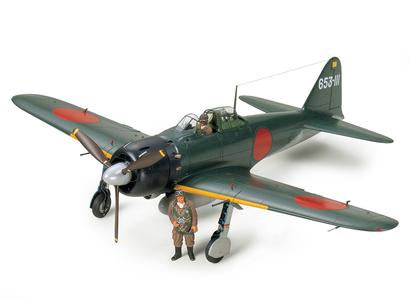Tamiya 1:32 A6M5 Zero Model 52
Tamiya 1:32 A6M5 Zero Model 52 is backordered and will ship as soon as it is back in stock.
Couldn't load pickup availability
Delivery and Shipping
Delivery and Shipping
We use tracked courier for fast delivery New Zealand wide
Description
Description
The Mitsubishi A6M Reisen (also known as Zero or Zeke) is a Japanese single-engine, full-metal low-wing fighter aircraft from the Second World War. The flight of the prototype took place on April 1, 1939, and it was put into service in the summer of 1940. The first prototypes were powered by a Mitsubishi Zuisei 13 engine, but from the A6M2 Model 11 onwards, the Nakajima NK1B Sakae 12 engine with 950 HP was used, which made the aircraft one of the best fighters early war period. New versions were created just before and during the war. One of the most famous was the A6M2 Model 21, a special version with folding wings designed for aircraft carriers, prepared at the beginning of the Pacific War, which became the basic Japanese on-board fighter. The next versions are A6M3 and A6M5, each of which had several versions. The first one used the 1130 HP Nakajima Sakae 21 engine with a compressor, which, however, meant an increase in weight and a decrease in range and maneuverability. Attempts were made to solve this problem in the A6M5 version by changing the exhaust system, changing the shape of the wings and resigning from folding them, which increased the top speed. The flight of this version took place in 1943 and was in production until the end of the war. It is worth noting that one of the most widely produced versions of the A6M5 was the A6M5C Model 52C «Hei» aircraft, of which nearly 5,000 were produced. "Zero" planes took part in the entire war in the Pacific, serving primarily as deck fighters, but also to a large extent as Army fighters. The "father" of this famous aircraft was the engineer Jiro Horikoshi, who relied on the experience gained from working on the M5A aircraft. He managed to develop a very maneuverable plane, with excellent aerodynamic properties, perfect for combat and with a large range. However, this was achieved at the expense of armor and the lack of self-sealing fuel tanks. What's more, due to the lack of aircraft engines with a power comparable to American machines, every year of the war, "Zero" from the "supercar", from 1943, evolved towards the weaker rival P-51, P-47 or F-4 or F- 6. It also turned out to be a machine vulnerable to damage and very vulnerable to fire. However, this does not change the fact that the Allies, until 1943, did not have an aircraft that would be able to compete with the A6M Zero. Technical data (A6M2 model 21 version): length: 9.06m, wingspan: 12m, height: 3.05m, maximum speed: 533km / h, rate of climb: 15.7m / s, maximum range: 3105km, maximum ceiling 10000m , armament: fixed - 2 20mm Type 99-1 cannons and 2 7.7mm Type 97 machine guns, suspended - up to 250 kg of bombs.
Payment & Security
Payment methods
Your payment information is processed securely. We do not store credit card details nor have access to your credit card information.




